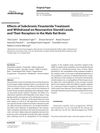TLDR Trilostane may help delay epilepsy development by increasing certain brain chemicals.
The study on 103 adult male Sprague Dawley rats found that trilostane did not affect the development of status epilepticus (SE) or hippocampal damage but significantly increased brain levels of allopregnanolone and suppressed pregnanolone synthesis. Repeated trilostane injections delayed the onset of seizures, suggesting its potential to modulate epileptogenesis, although a single injection was ineffective. These results indicate trilostane could be a promising agent for delaying epileptogenesis by increasing neurosteroid levels, particularly allopregnanolone.
20 citations
,
January 2017 in “Epilepsia” Blocking neurosteroid production can lead to more seizures and faster epilepsy onset in rats.
 33 citations
,
December 2015 in “Neuroendocrinology”
33 citations
,
December 2015 in “Neuroendocrinology” Finasteride treatment changes brain steroid levels and receptors, affecting brain function even after stopping treatment.
 26 citations
,
July 2012 in “Epilepsy & Behavior”
26 citations
,
July 2012 in “Epilepsy & Behavior” Finasteride worsens seizures in epilepsy rats and speeds up epileptogenesis in mice.
62 citations
,
January 2009 in “Epilepsia” Neurosteroid production in the brain may delay seizure onset.
 61 citations
,
January 2008 in “Biological & Pharmaceutical Bulletin”
61 citations
,
January 2008 in “Biological & Pharmaceutical Bulletin” Finasteride almost fully depletes allopregnanolone in rat brains and enhances 20α-DHP, but doesn't change 3α-DHP levels.
81 citations
,
June 2006 in “Experimental Neurology” Neurosteroids may help prevent seizures in epilepsy.
March 2023 in “Epilepsia” Trilostane may help delay epilepsy development by increasing certain brain chemicals.
April 2015 in “The FASEB Journal” Midazolam's antiseizure effects are mainly due to synaptic GABA-A receptors, not neurosteroids or extrasynaptic receptors.
24 citations
,
January 2007 in “The FASEB Journal” Neurosteroid withdrawal increases seizure frequency in a rat model of catamenial epilepsy.


